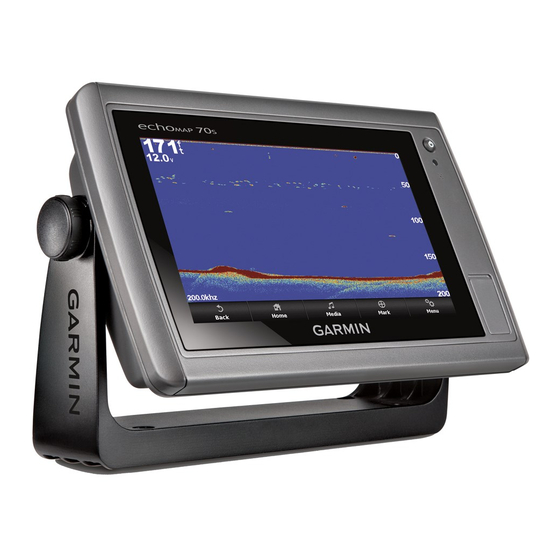Time Zone: Sets the time zone, or allows automatic selection
based on GPS location.
Navigation Settings
NOTE: Some settings and options require additional charts or
hardware.
Select Settings > Navigation.
Route Labels: Sets the type of labels shown with route turns on
the map.
Auto Guidance: Sets the measurements for the Safe Depth,
Safe Height, and Shoreline Distance, when you are using
some premium maps.
Turn Transition Activ.: Sets the turn transition to be calculated
based on time or distance.
Turn Transition Time: Sets how many minutes before the turn
that you transition to it as the next leg, when Time is selected
for the Turn Transition Activ.. You can raise this value to help
improve the accuracy of the autopilot when navigating a route
or an Auto Guidance line with many frequent turns or at
higher speeds. For straighter routes or slower speeds,
lowering this value can improve autopilot accuracy.
Turn Transition Dist.: Sets how far before the turn that you
transition to it as the next leg, when Distance is selected for
the Turn Transition Activ.. You can raise this value to help
improve the accuracy of the autopilot when navigating a route
or an Auto Guidance line with many frequent turns or at
higher speeds. For straighter routes or slower speeds,
lowering this value can improve autopilot accuracy.
Route Start: Selects a starting point for route navigation.
Other Vessel Settings
When your compatible chartplotter is connected to an AIS
device or VHF radio, you can set up how other vessels are
displayed on the chartplotter.
Select Settings > Other Vessels.
AIS: Enables and disables AIS signal reception.
DSC: Enables and disables digital selective calling (DSC).
AIS Alarm: Sets the collision alarm
Collision Alarm
and
Enabling AIS Transmission Test
Restoring the Original Chartplotter Factory
Settings
NOTE: This will delete all settings information you have entered.
Select Settings > System > System Information > Factory
Settings.
Appendix
Registering Your Device
Help us better support you by completing our online registration
today.
• Go to http://my.garmin.com.
• Keep the original sales receipt, or a photocopy, in a safe
place.
Cleaning the Screen
Cleaners containing ammonia will harm the anti-reflective
coating.
The device is coated with a special anti-reflective coating which
is very sensitive to skin oils, waxes, and abrasive cleaners.
Appendix
(Setting the Safe-Zone
NOTICE
1
Apply an eyeglass lens cleaner specified as safe for anti-
reflective coatings to the cloth.
2
Gently wipe the screen with a soft, clean, lint-free cloth.
Screenshots
You can capture a screenshot of any screen shown on your
chartplotter as a bitmap (.bmp) file. You can transfer the
screenshot to your computer.
Capturing Screenshots
1
Insert a memory card into the card slot.
2
Select Settings > System > Display > Screenshot Capture
> On.
3
Go to a screen you want to capture.
4
Hold HOME for at least six seconds.
Copying Screenshots to a Computer
1
Remove the memory card from the chartplotter, and insert it
into a card reader that is attached to a computer.
2
From Windows
memory card.
3
Copy a .bmp file from the card and paste it to any location on
the computer.
Troubleshooting
My device will not acquire GPS signals
If the device is not acquiring satellite signals, there could be a
few causes. If the device has moved a large distance since the
last time it has acquired satellites or has been turned off for
longer than a few weeks or months, the device may not be able
to acquire the satellites correctly.
• Ensure the device is using the latest software. If not, update
the device software
My device will not turn on or keeps turning off
Devices erratically turning off or not turning on could indicate an
issue with the power supplied to the device. Check these items
to attempt to troubleshoot the cause of the power issue.
• Make sure the power source is generating power.
Alerts).
You can check this several ways. For example, you can
check whether other devices powered by the source are
functioning.
• Check the fuse in the power cable.
The fuse should be located in a holder that is part of the red
wire of the power cable. A 3 Amp fuse is used in this power
cable. Check the fuse to make sure there is still a connection
inside of the fuse. You can test the fuse using a multimeter. If
the fuse is good, the multimeter reads 0 ohms.
• Check to make sure the device is receiving is at least 10
volts, but 12 volts is recommended.
To check the voltage, measure the female sockets 8 (power)
and 2 (ground) of the power cable for DC voltage. If the
voltage is less than 10 volts, the device will not turn on.
• If the device is receiving enough power but does not turn on,
contact Garmin product support at www.garmin.com/support.
My device is not creating waypoints in the correct
location
You can manually enter a waypoint location to transfer and
share data from one device to the next. If you have manually
entered a waypoint using coordinates, and the location of the
point does not appear where the point should be, the map
datum and position format of the device may not match the map
datum and position format originally used to mark the waypoint.
Position format is the way in which the GPS receiver's position
appears on the screen. Commonly displayed as latitude/
Explorer, open the Garmin\scrn folder on the
®
(Updating the Device
Software).
21

